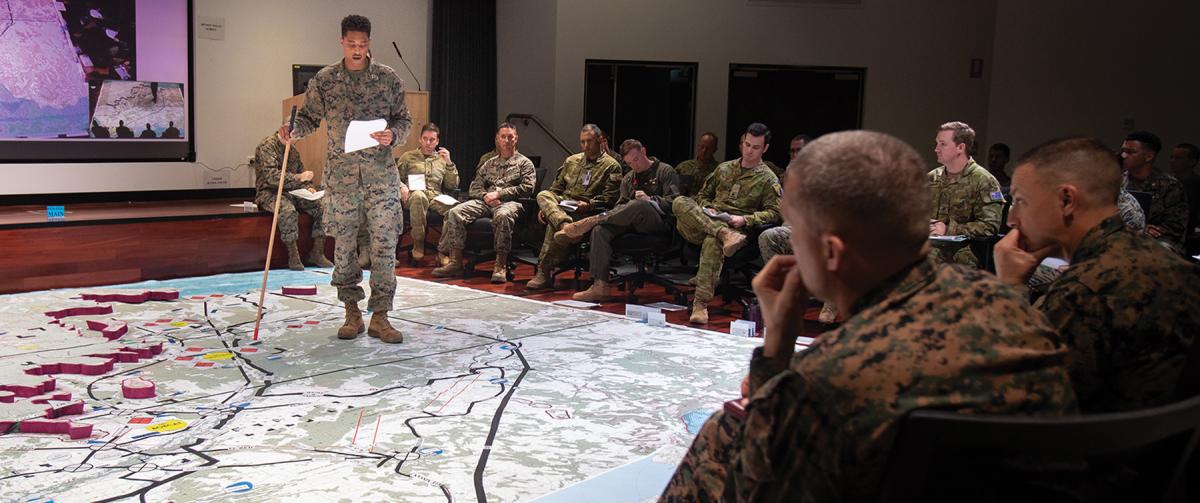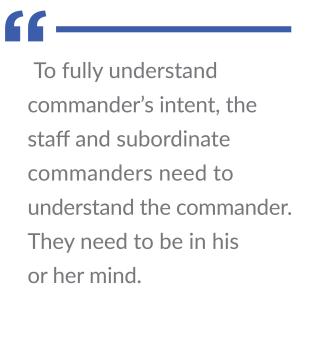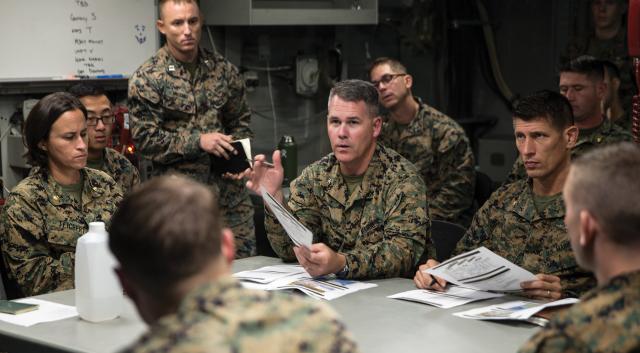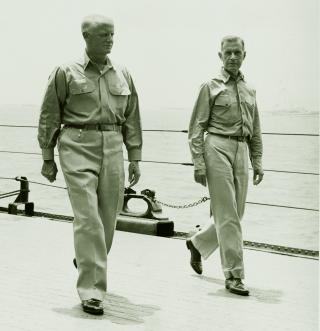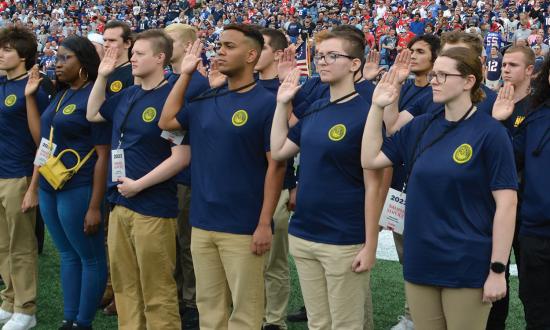Simple plans are the hardest to develop because they require critical thinking, creativity, and imagination to distill complex problems to their essence and develop approaches to solve them. Today, the national security environment is more complex and chaotic than in the late Cold War. The environment is characterized by great power competition and the increasing risk of great power conflict. The United States faces threats in more domains, including cyber and space, and the threats range from a multitude of state to nonstate actors. The nation, along with its allies and partners, is developing new resources and capabilities to counter these threats, but harnessing them effectively offers challenges.
Faced with growing complexity and chaos, can the U.S. military still develop and execute plans that are resilient and agile? With limited staff, time, logistics, and weapons, crafting perfect plans wastes resources, and the enemy gets a vote. “Understand the Adversary: Respect Their Intentions and Capabilities” is the first section in Naval History and Heritage Command’s paper on planning the Pacific war.1 Plans will be probed and tested by the enemy and, therefore, must be resilient and agile.
So, how does a staff develop winning plans at the operational level of war? The joint force has planning doctrine to achieve these characteristics, but operational design and the joint planning process (JPP) require focus and must incorporate both the art and science of war. Art weighs more heavily than science in operational design, but science is more essential to the planning process. Understanding the duality of art and science and the symbiotic relationship between operational design and the JPP are key.
Joint Planning Doctrine
Joint Publication 5-0, Joint Planning, states, “Joint planning is the deliberate process of determining how to implement strategic guidance: how (the ways) to use military capabilities (the means) in time and space to achieve objectives (the ends) within an acceptable level of risk.”2 This deliberate process includes the JPP along with operational design methodology.3 The JPP is better known and understood and consists of seven steps: planning initiation, mission analysis, course of action (COA) development, COA analysis and wargaming, COA comparison, COA approval, and plan (or order) development.4 Operational design, which is lesser known and understood, is defined as “the analytical framework that underpins planning. Operational design supports commanders and planners in organizing and understanding the operational environment as a complex interactive system.”5 Operational design methodology consists of nine steps that can be distilled to three main points: understand the situation, identify the problem, and develop an operational approach.
Together, JPP and operational design are complementary elements of joint planning. In his October 2009 Vision for a Joint Approach to Operational Design, then–Marine Corps General James Mattis observed that standard planning processes had served the military well to that point.However, he wrote that commanders and staffs tend to use these processes somewhat mechanically, with a focus on procedure and details that often obscures the importance of the creative process. The complexity of current and projected challenges requires critical thinking, creativity, foresight, and adaptability—rather than strict reliance on methodical steps—to become routine.6 In his vision, General Mattis sought to balance the mechanistic JPP with the creative approach of operational design and, thereby, improve joint planning by incorporating both the art and science of war.
The nature of war involves both art and science. Naval War College Professor Milan Vego addressed this duality when he wrote, “The idea that the conduct of war is a science is almost as old as warfare itself.”7 Vego added, “The view that the conduct of war is largely an art is not entirely new.”8 Art refers to the creative, imaginative, intuitive, human factors, whereas science refers to the analytical, theoretical, and technological factors. Military art emphasizes mastering war through the human lens, including experience, judgment, and intuition, stressing the subjective decision-making abilities of commanders. Military science emphasizes mastering war through an analytical lens, stressing the systematic and analytical study of warfare, using scientific methods and theories to solve military problems. In his article, Vego expertly takes the reader through a historical account of the art-vs.-science debate and concludes, “Our knowledge and understanding of warfare is a science, but the conduct of war itself is largely an art.”9
The Commander, Operational Design, and Operational Art
The commander is central to this dual approach. As described in a Joint Staff J7 paper, “Operational design is commander-centric and largely an ‘art of war’ versus ‘science of war’ endeavor. Commander’s engagement is central to the development of an operational approach. This is the culmination of the efforts to understand the environment and identify the problem.”10 Why is the commander central? Because the commander brings experience, education, intuition, judgment, and the vision expected to link specific actions of the joint force to broad strategic end states.11 In creating the operational design, the commander applies operational art, which Joint Planning defines as “the cognitive approach by commanders and staffs—supported by their skill, knowledge, experience, creativity, and judgment—to develop strategies, campaigns, and operations to organize and employ military forces by integrating ends, ways, means, and evaluating risks.”12
The planning process derives from a methodical, mechanistic planning approach inherited from the conduct of land warfare—for example, from European wars in which roads, number of soldiers, march times, battleground conditions, length of firing lines, and mass of fire concentrated on the center were valuable planning factors. In today’s strategic and operational environments, the complexity of competition and conflict demands a greater understanding and a more imaginative approach—one that requires critical thinking, creativity, foresight, and adaptability. Operational design is intended to provide that approach, enabling critical and creative thinking to better understand and describe poorly defined problems and visualize broad approaches to solve them. Operational design is all about understanding the situation, identifying the problem, and developing an operational approach.13 “Design does not replace planning, but planning is incomplete without design. The balance between the two varies from operation to operation as well as within each operation. Design helps the commander provide enough structure to an ill-structured problem so that planning can lead to effective action toward strategic objectives.”14
A war with China in the western Pacific in this decade would be so paradoxically complex, interrelated, interdependent, uncertain, unpredictable, and chaotic that the operational situation may seem impossible to understand. That is why the cognitive approach of operational art is fundamental. Done well, it will provide an ability to see through the clutter and fog to the crux issues, to distill a complex situation to its essence. Perceiving the situation and the problem should lead to a vision and creative process for how to overcome it. The vision becomes the operational approach—a broad framework to overcome the problem.
OperAtional Design and JPP Together
How do operational design and the JPP work together? Operational design provides the framework of a broad operational approach to solve the problem. Given the operational approach, planners use the JPP with its orderly, analytical set of steps to refine operations to solve the problem: determine a mission; develop, analyze, and compare COAs; select a COA; and produce a concept of operations or an order.15 The JPP’s scientific approach fills in with detail the broad brush strokes of the operational approach. In addition, operational design and JPP work together iteratively during plan execution. With a good assessment process, the commander and staff may identify and determine conditions that have changed during execution that warrant revisiting the operational approach or plan. For example, a change in the operational environment, being off plan, or a change in an underlying assumption may necessitate updating the understanding of the situation, reframing the problem, and subsequently adjusting the operational approach and corresponding plans. Simply put, operational design and the JPP—if properly used together—can build resiliency and agility into planning.
Planning Observations
Having focused on operational design and the JPP, the following practical observations are offered:
Commander’s Involvement
The personal involvement of the commander cannot be overemphasized. Commanders bristle when micromanaged from above. They yearn for mission command. The basic principles of mission command are commander’s intent, mission-type orders, and decentralized execution, with mission statement and commander’s intent being products of JPP.16 Developing a deep understanding of commander’s intent is challenging, particularly when commander’s intent is conveyed in written form. To fully understand commander’s intent, the staff and subordinate commanders need to understand the commander. They need to be in his or her mind. This requires interaction and dialogue. Therefore, a commander who frequently engages subordinate commanders, staff, and planners builds a high level of understanding. This understanding underpins good planning because the planning products and the processes that develop them are infused with the commander’s intent and logic, which enables mission command.
The commander also provides guidance that fills in gaps from higher headquarters. In addition, the iterative dialogue between subordinates, the staff, and planners stimulates the commander’s own critical thinking and creative process. Through this give-and-take dialogue, the commander conveys how to fit the various pieces together in a resilient and agile plan.
Four Functions
The joint force brings firepower and effects to bear. Ideally, it operates with unity of command. Unfortunately, that is neither realistic nor likely given the complexity of the command-and-control (C2) structures among the vast number of commands working in multiple supported and supporting relationships. Internal friction affects the unity of effort, speed, and tempo of operations, and this friction will worsen during crisis and conflict because of internal and external factors. The most important external factor is enemy action. Four actions—coordination, integration, prioritization, and synchronization—can reduce friction in planning and execution. Coordination is the process of organizing people or groups so that they work together properly and well; integration is the process of blending into a functioning, unified whole; prioritization is the process of listing or rating things in order of priority; and synchronization is the process that makes actions work together in operation.
Supported and supporting relationships between commands and the forces and effects they bring to bear must be coordinated, integrated, prioritized, and synchronized. For example, how are all domain fires synchronized when a combatant commander may have neither operational control nor the delegated authority to use the fires? Are the C2 structures capable of synchronizing the fires at the right times and places? Is coordination good enough to achieve synchronization? Does the prioritization ensure availability of fires at the right time?
All Domain/Multidomain/Joint Fires
In conflicts ranging from Operation Desert Storm through Operations Enduring Freedom and Iraqi Freedom, the U.S. military enjoyed the capability to deliver firepower from multiple domains against practically any target at a time and place of its choosing. Against today’s peer adversaries—particularly against the Chinese military—that likely will not be true. Joint fires and schemes of maneuver will be contested in tomorrow’s battles. While the U.S. joint force has experience synchronizing multidomain fires, effective synchronization becomes more challenging as the number of domains increases. With the growing importance of the space and cyber domains, planning must account for the additional complexity in executing and synchronizing fires in all domains against an agile, capable enemy. Commanders and their staffs must understand the situation in the less familiar domains of space and cyber to include associated opportunities, vulnerabilities, and risk. The art must not lag the science. All domains must factor into operational design methodology and resulting approaches.
Decision Space
It is important to give the commander as much time as possible to make decisions. To do this, the staff must answer many questions, including: what decisions need to be made; who needs to make them; what information is required; who has the authority to make the decisions; who needs to be included in the decisions; how much time it will take to make the decisions; how far in advance the decisions need to be made to achieve desired effects; and what actions will be taken when decisions are made. Understanding and answering these questions affords the commander greater temporal awareness of the decision space, enabling more agile maneuver. Potential benefits from this agility include adjusting the tempo of operations for advantage; operating inside the enemy’s decision cycle; looking further ahead instead of being captured by the now; and giving higher authorities more time to make a decision.
Enemy Courses of Action
It has always been true that the enemy “gets a vote,” but in the past 30-plus years, the U.S. military has not been accustomed to the enemy getting a decisive vote at the tactical level, especially in the naval domain. Given how fundamental understanding and knowing the enemy is to operational design, this is articulated in the JPP. A prime example is the use of enemy courses of action (ECOAs). Common JPP practice identifies most likely and most dangerous ECOAs, which essentially set the left and right limits of assumed enemy action. Proposed friendly COAs are war gamed against these left and right enemy limits, and the friendly COAs are compared based on their success. Eventually a COA is chosen, with the underlying assumption that the enemy will act within predicted left and right limits.
But what happens if the enemy acts differently? What if the enemy’s actions are more dangerous than the most dangerous ECOA? Can the commander, staff, and engaged forces recognize what the enemy is doing? They must be able to see changes in the operational environment. They must revisit the situation, reframe the problem, and change the operational approach. They might need to execute a branch plan or sequel or come up with a new plan. Resilient and agile planning incorporates operational design methodology that can overcome this potential blind spot.
Time to Rebalance
In the 1980s, U.S. military art and science leaned heavily toward peer competition with the Soviet Union. After the Cold War, and especially after 9/11, it shifted toward counterterrorism and now back to peer competition. Today’s joint force has significant experience fighting terrorists but little in fighting a peer competitor that can challenge in every domain. China has closely studied the U.S. way of war. What happens when, in crisis or conflict, the enemy simultaneously denies or disrupts U.S. military command and control, creating a lapse in C2? Are U.S. plans and forces resilient and agile enough to absorb the first punch and keep fighting? Commander’s intent, mission command, all-domain fires, and the ability to maneuver in the decision space must be resilient enough to keep going. Creating that resiliency means the joint force must rebalance toward critical thinking, creativity, and imagination—otherwise known as the art of war.
Admiral Nimitz Understood Operational Design
By Captain Gerry Roncolato, U.S. Navy (Retired), with the help and guidance of Trent Hone
While the term “operational design” is relatively new to the lexicon, it would be easily recognizable to World War II commanders, including Fleet Admiral Chester Nimitz, Admiral Raymond Spruance, and their planning staffs. Operation Flintlock in the Marshall Islands illustrates this historical connection.
Under pressure from Fleet Admiral Ernest J. King and the Joint Chiefs of Staff, Nimitz constantly pushed his command to go faster. This required frequent reorganizations as the scope and magnitude of the war grew and as the Pacific Fleet staff correspondingly expanded into the Commander, Pacific Ocean Area, joint staff.1
Nimitz’s command style was ideally suited to accelerate his central Pacific campaign, keeping the Japanese back on their heels while also meeting demands from Washington. Nimitz kept his staff small (compared to corresponding Army staffs) to maximize flexibility, responsiveness to the commander’s intentions, and adaptability.2 Nimitz provided overarching guidance and let his subordinates do the detailed planning, but he remained intimately involved throughout to provide feedback to the planners and to ensure they were proceeding in line with his objectives.
Operation Flintlock followed the conquest of the Gilbert Islands and commenced in early 1944. Nimitz provided what would now be called the operational design. Always seeking opportunities to exploit, he left the objectives of the operation rather open, other than that it would entail the reduction of Japanese defenses in the Marshalls.3
Nimitz laid out the broad contours of the plan and, when it became clear that the best approach would be to bypass the eastern Marshalls and strike directly at Kwajalein, he focused his subordinates’ attention there. He directed the striking power of the Pacific Fleet using “a multidimensional array of carriers, amphibious assault forces, land-based planes, and surface ships [to] . . . enter the island group, overwhelm enemy defenses, and seize Kwajalein and Majuro.”4 Spruance’s staff then developed the detailed plan and issued it just weeks before the landings.
Myriad other examples could be presented. Throughout military history, good commanders have provided the essence of operational design to guide their staffs in developing detailed operational plans. Those same commanders then remained engaged in the planning process, resolving differences and keeping the plan on track.
1. Trent Hone, Mastering the Art of Command: Admiral Chester W. Nimitz and Victory in the Pacific, (Annapolis, MD: U.S. Naval Institute Press, 2022), 212–213.
2. Hone, Mastering the Art of Command,187.
3. Hone, 213.
4. Hone, 222.
1. Naval History and Heritage Command, “Richmond Kelly Turner–Planning the Pacific War,” 1.
2. Joint Publication 5-0, “Joint Planning” (Washington, DC: The Joint Staff, 1 December 2020), xi.
3. Joint Publication 5-0, III-4.
4. Joint Publication 5-0, III-10.
5. Joint Publication 5-0, xxi.
6. Planner’s Handbook for Operational Design (Suffolk, VA: Joint Staff J-7, Joint and Coalition Warfighting, 7 October 2011), preface.
7. Milan Vego, “Science vs. the Art of War,” Joint Force Quarterly 66 (3rd quarter 2012): 62.
8. Milan Vego, “Science vs the Art of War,” 66.
9.Milan Vego, “Science vs the Art of War,” 69.
10. “Design and Planning,” Insights and Best Practices Focus Paper (Suffok, VA: Joint Staff J-7, Deployable Training Division, 1st ed., July 2013), 7
11. Planner’s Handbook for Operational Design, III-1
12. Joint Publication 5-0, xii.
13. “Design and Planning,” 3.
14. Gen James Mattis, USMC, “Vision for a Joint Approach to Operational Design,” 6 October 2009.
15. Joint Publication 5-0, III-10
16. GEN Martin Dempsey, USA, “Mission Command White Paper,” The Joint Staff, 3 April 2012, 3.



